



So, you have been set the challenge of bringing your product to market, the electronics complete, PCB’s printed but finding the perfect off the shelf enclosure is proving to be impossible! Even with a huge range of off the shelf enclosures available it is not always possible to find something that perfectly fits your requirement. Varying factors including styling, size constraints, colour requirements, material preference and IP rating requirements may mean that the ideal product does not even exist! In this instance producing your own custom enclosure is the solution.
Producing your own custom enclosure comes with many benefits, you have the absolute freedom to design a product that perfectly represents your company branding, fits your components and satisfies your material and IP rating needs, but where do you start and which is the best method
3D Printing
3D printing is an emerging technology within the enclosure industry and currently lends itself best to prototyping and small production runs. If you need to see a physical example of your design to check the fitment of your components or perhaps you need a demonstration enclosure for a proposal, 3D printing is ideal. Whilst the end finish is not as polished compared with alternate options such as injection moulding it allows you to produce your custom enclosure without the need for upfront tooling costs and you can make an unlimited amount of changes until the model is perfect.
Tool-less Fabrication
Tool-less fabrication is a very popular option for both small and large production runs and like 3D printing eliminates the need for a tool from your production costs. The material is stored in sheet form and the various parts of the design are precision cut and folded to produce the design required. There are very few limitations as to what can be created ranging from small control boxes to large IP rated cabinet enclosures. Initially, this type of manufacture is faster than injection moulding because there is no need to manufacture a tool first and the method is preferable if you expect the design to vary through the products life as there is no tool to modify. There are vast material choices available, so the customer has flexibility when specifying the flammability rating and colour.
Injection Moulding
Injection moulding is perhaps the most common form of manufacture in the enclosure industry. Whilst the set-up costs are typically higher than 3D printing and tool-less fabrication the unit cost is much lower. This type of manufacture is not favoured for small production runs and there will be minimum order quantities specified by the manufacturer that will usually depend on the chosen colour, material and size of the product. This option is the most cost-effective for production that is expected to be repeated regularly and without change to the design which is not always possible once finalised. There are very few limitations to what can be created with injection moulding including curved surfaces which is not always possible with tool-less manufacture. Compared to 3D printing and tool-less manufacture injection moulding creates the best overall finish as there are no printing lines or changes in the finish where parts have been bonded.
In some instances, you may be fortunate to find the perfect off the shelf product, the manufacturer will often offer customisation options and may offer to mould in custom colour or material if required. Typically, an off the shelf product will require some form of CNC machining, screen printing and label making so your components can be installed, and branding added. It is worthwhile talking to your enclosure manufacture about the custom options they have available, having your chosen product delivered complete with modification means you will not incur costs for any damages during the modification process and can often be quicker if these services are ordinarily outsourced.

It is important to evaluate the needs of the project prior to proceeding with any custom manufacture, choosing an off the shelf product carries less risk and will save you design costs however on occasion you may need to make compromises in design. You should take time to consider the future of your product, if the entire project is for 100 units then injection moulding is not the best option due to the initial set up fees, equally, you would not specify 3D printing for large scale production. Many people now choose to use a variety of production methods before bringing a complete and definite product to market.

3D Printing
Finalise your design and produce a 3D model, build the prototype unit and test. Depending on the success of your trial make necessary changes with minimal costs. Once the final design is approved move to small scale production runs.
Tool-less Fabrication
Depending on the demand and confidence you have in the product consider small production runs using tool-less manufacturing. This process allows customers to gauge sales and ensure the product is performing correctly in its enclosure, mitigating risks before moving on to a more permanent supply option.
Injection Moulding
Having spent time perfecting the enclosure in earlier stages have a tool made with the confidence to buy in quantity and benefit from the savings that custom injection moulding offers compared to tool-less options.
To conclude taking the time to properly plan your product, realise its strengths and weaknesses, further developing along the way will ensure you truly benefit from manufacturing a custom enclosure. If you need help deciding which plastic enclosure to use for your product, give us a call on 01908 325100 of fill in this contact form.